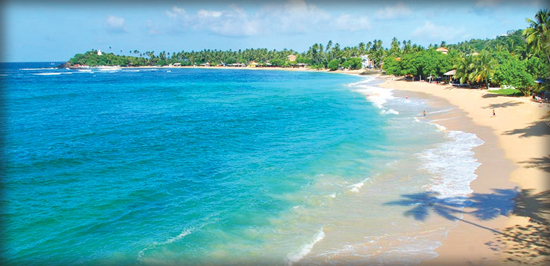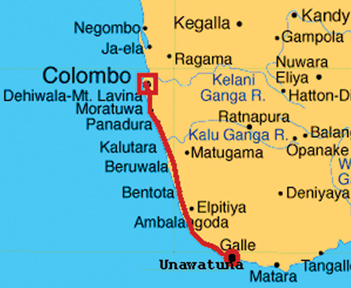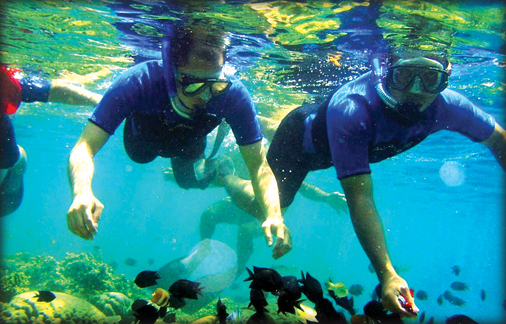Unawatuna: The world’s beach
“I have seen
the sea lashed into fury and tossed into spray and its grandeur moves
the soul of the dullest man; but I remember that it is not the billows
but the calm level of the sea from which all heights and depths are
measured”.
- James A. Garfield (US President
1881)
By kalakeerthi Dr. Edwin Ariyadasa
|

The beach as it used to be... |
The Unawatuna beach is an eco-treasure, that no site on earth can
equal. At first this may sound a rash, hyperbole. One could even aver
that this is unreined, uninhibited exaggeration, determined perhaps by
deeply entrenched personal prejudice.
Before I muster solid evidence to bolster my seemingly strange claim
for Unawatuna beach, I must turn to the immediate cause that prompts
this article.
Nostalgic pangs
In recent days, there has been a spirited public discourse about
threats that are likely to mar the allure of this natural endowment.
These moved me sorely, because I am one of those few surviving
individuals who have been able to witness and relish the pristine charm
of the Unawatuna beach, long before organised tourism entered into the
scene.
My nostalgic pangs were considerably sharpened by an emotionally
tinged reflection from Paloma Scott, Director Calamander Unawatuna
beach. This is his plea: “One thing is for certain. Unawatuna Bay’s
beauty remains undiminished. This natural treasure should be cherished
by the nation, nurtured and protected. We all ignore Unawatuna Bay’s
future at our peril.”
My emotional attachment to Unawatuna Bay, dates back to a time about
80 years ago, when I was a teenager living in Unawatuna - my
birth-place.
I was in a peer group, that was staunchly dedicated to art,
literature and generally-aesthetics. We would of an evening saunter to
Unawatuna beach which was somewhat a sleepy locale back then.
Seated on a convenient perch on the shore, at the edge the sea, in
the interface between the land and the bay-line, we would watch the sea,
with engrossed fascination. In the gush of enthusiasm, we would
sometimes recite poetry, adding our ephemeral voices to the perpetual
roar of the sea. All those companions are now gone.
(Two of them were well-known Hela enthusiasts - Anandapiya Kudathihi
and Reggie Weeraman).
Billows
The U-shaped Unawatuna Beach was an uninterrupted stretch of inviting
sand. The waves, encountering the layers of rock would raise billows.
When the sea reaches the shore, it forms a calm natural swimming pool.
This way we discovered the enchantment of the Unawatuna Bay, even
before Arthur C. Clarke - the Scuba-diving communications sage, who
rated this beach as one of the world’s best. Clarke rented a house in
Unawatuna way back in 1956. But, we imbibed its charm at least 15 years
prior to his discovery of its assets. (Incidentally, Clarke rented out a
house at Unawatuna, from D.T. Amarasinghe - a school-mate of mine from
childhood).
 About eight decades ago, at the western edge of the Bay, there was an
ancient temple (Devale) sited on a rocky abutment. In the days of our
childhood, this was desolate for a good part of the year. But, when its
annual feast takes place in the month of Esala, devotees foregather in
tens of thousands. The rituals held there were quite akin to those at
Kataragama. A fire-walk was part of the festival, this cult, extends to
the far past. About eight decades ago, at the western edge of the Bay, there was an
ancient temple (Devale) sited on a rocky abutment. In the days of our
childhood, this was desolate for a good part of the year. But, when its
annual feast takes place in the month of Esala, devotees foregather in
tens of thousands. The rituals held there were quite akin to those at
Kataragama. A fire-walk was part of the festival, this cult, extends to
the far past.
In the days of our childhood, the sea associated with the Bay, did
not stir with life, to a noteworthy extend. Some fisher-folk may go out
in the night, in their frail outrigger-canoes, for deep sea fishing,
when they come ashore in the morning with their catch, the vendors,
bearing pingos, take the fresh fish for sale.
But, Unawatuna Bay, though somnolent in our childhood days has a
history that reaches back to ancient times. A convenient sea-current,
brought sailing ships to this tranquil Bay, still bears the name JA-Kotuwa
(The Javenese settlement) indicate the Bay’s link with ancient JAVA.
We can compare this with cheena koratuwa - Chinese settlement - in
Galle).
Tradition has it, that, a God (Devol - according to folklore) landed
here, sailing in a stone - raft. The cult of this deity had been
practised by the people around the Bay, as long as they can remember.
Cults converging on Unawatuna lead us to the name of the place.
Popular etymology has it that Unawatuna comes from the expression
‘Onna Vatuna’ (“There, it fell”). This is pure folk-figment. It is
derived from Oona Pattana (Little Bay) - Una-Patuna. Many places along
the coastline have been named Patuna - to mean Bay.
This brings us to yet another aspect of the mystery that provides an
absorbing halo to the Unawatuna story.
Indian epic
It has to do with the world-renowned Indian epic Ramayana, by Valmiki.
The core-theme of this Indian epic is the mythical encounter between
Rama and Ravana. When Rama’s brother Lakshman was near fatally wounded
in battle, there was only scant hope about his life. The Prince’s life
could be saved only if four medicinal herbs were fetched from the
Himalayas. Speed was of the highest essence. The Monkey-God undertook
the mission.
But, on location, Hanuman forgot the names of the herbs that were
needed. Without wasting time to try and remember, Hanuman grabbed the
part of the Himalayas with the herbs. After the herbs were taken he
threw off the remaining chunk of the mountain.
That chunk fell to the ground forming Rumassala, adjacent to
Unawatuna Bay. Rumassala could be rendered as “The Beautiful Rock”.
Strangely enough, its present name “Buona Vista” seems an echo of the
original “Rumassala”.
 Because of this “Fall”, the name Unawatuna (onnavatuna) occurred
according to some. Because of this “Fall”, the name Unawatuna (onnavatuna) occurred
according to some.
There is yet another “Fall”. There is a place, in the Bay of
Unawatuna, that does not come into the magnetic grid, that covers the
whole of the Earth’s surface. This point may have occurred, because some
object from outer-space fell here billions of years ago. Its magnetic
force is potent, that it can attract even the earth’s magnetic pull into
it creating a vacuum here.
Clarke has said that communications satellites, orbiting 22,300 miles
above earth, float and stay above Unawatuna Bay, when they exhaust their
fuel.
This rocky escarpment called Rumassala, made up of igneous rock, may
have originated from a meteor that fell here, several billion years ago.
And, of course, there is the port of Galle next door. Galle derives from
Galla, implying forest (Attanagalla-forest of Attana Trees). Even king
Soloman’s ships, called at Galle, to take away such exotic items as
spices, ivory, peacocks, gems and elephants.
Where else on earth to all these converge on the point. On top of all
that, at a stretch of Beach, rarely equalled by any other such natural
occurrence.
We must protect preserve and perpetuate this Nature’s Gift
- Unawatuna Beach.
|

